1996 CHEVROLET MONTE CARLO tire type
[x] Cancel search: tire typePage 148 of 340

Downloaded from www.Manualslib.com manuals search engine 0 Check your mirrors, glance over your shoulder, and
start your left lane change signal before moving out
of the right lane to pass. When you are far enough
ahead of the passed vehicle to see its front in your
inside mirror, activate your right lane change signal
and move back
into the right lane. (Remember that
your right outside mirror is convex. The vehicle you
just passed may seem to be farther away
from you
than it really is.)
0 Try not to pass more than one vehicle at a time on
two-lane roads. Reconsider before passing the
next vehicle.
0 Don’t overtake a slowly moving vehicle too rapidly.
Even though the brake lamps are not flashing, it may
be slowing down or starting
to turn.
If you’re being passed, make it easy for the
following driver to get ahead of you. Perhaps you
can ease
a little to the right.
Loss of Control
Let’s review what driving experts say about what
happens when the three control systems (brakes, steering
and acceleration) don’t have enough friction where the
tires meet the road to do what the driver has asked.
In any emergency, don’t give up. Keep hying to steer and
constantly seek an escape route or area
of less danger.
Skidding
In a skid, a driver can lose control of the vehicle.
Defensive drivers avoid most skids by taking reasonable
care suited
to existing conditions, and by not “overdriving”
those conditions. But skids are always possible.
The three types
of skids correspond to your Chevrolet’s
three control systems. In the braking skid, your wheels
aren’t rolling. In the steering or cornering skid, too
much speed or steering
in a curve causes tires to slip and
lose cornering force. And
in the acceleration skid, too
much throttle causes the driving wheels to spin.
4-12
Page 167 of 340
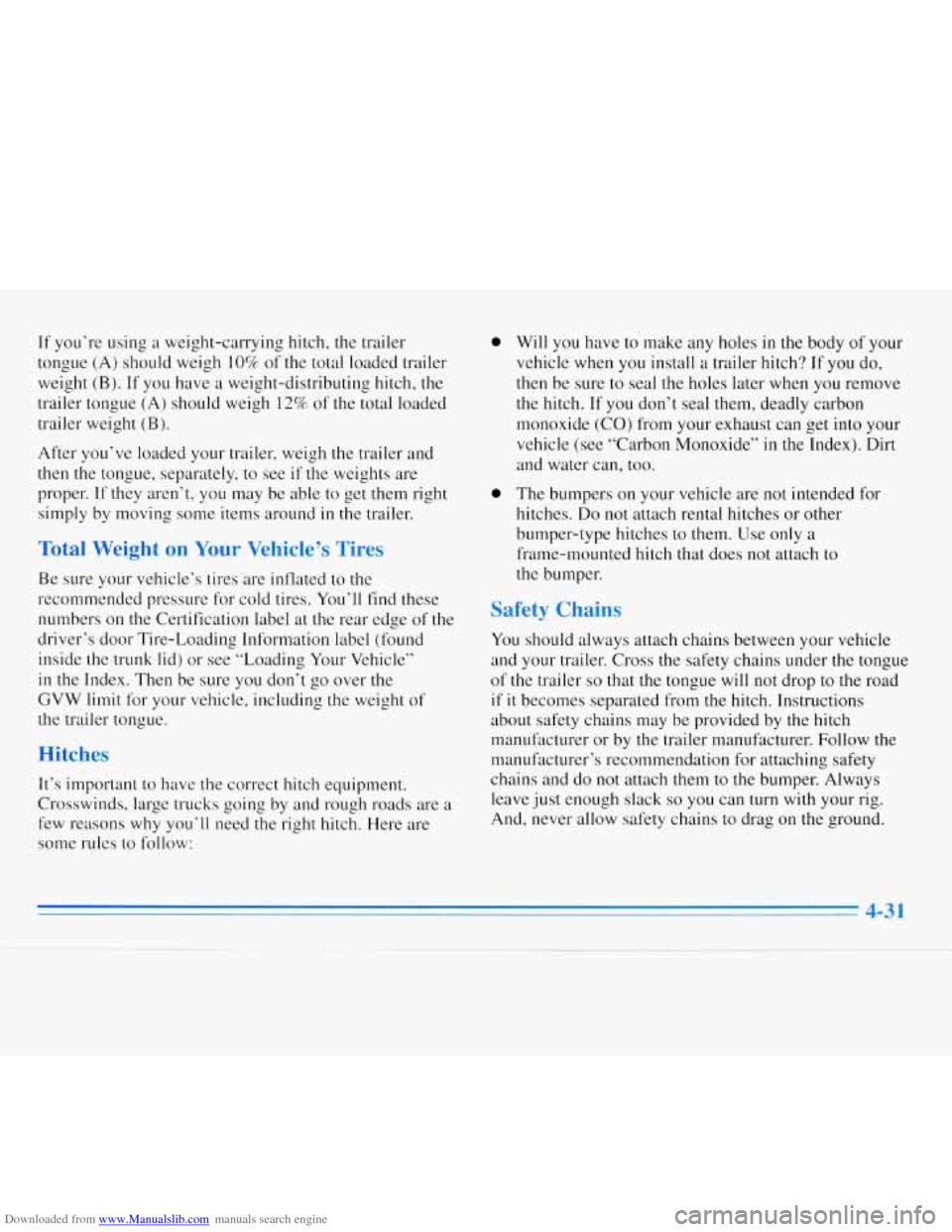
Downloaded from www.Manualslib.com manuals search engine If you’re using a weight-carrying hitch, the trailer
tongue (A) should weigh 10% of
the total loaded trailer
weight
(B). If you have a weight-distributing hitch, the
trailer tongue
(A) should weigh 12% of the total loaded
trailer weight
(B).
After you’ve loaded your trailer, weigh the trailer and
then the tongue, separately, to see
if the weights are
proper.
If they aren’t, you may be able to get them right
simply by moving some items around
in the trailer.
Total Weight on Your Vehicle’s Tires
Be sure your vehicle’s tires are inflated to the
recommended pressure for cold tires. You’ll find these
numbers on the Certification label at the rear edge of the
driver’s door Tire-Loading Information label (found
inside the trunk lid) or see “Loading Your Vehicle”
in the Index. Then be sure you don’t go over the
GVW limit for your vehicle, including the weight of
the trailer tongue.
Hitches
It’s important to have the correct hitch equipment.
Crosswinds, large trucks going by and rough roads are
a
few reasons why you’ll need the right hitch. Here are
some rules to follow:
0
a
Will you have to make any holes in the body of your
vehicle when you install a trailer hitch? If you do,
then be sure to seal the holes later when you remove
the hitch. If you don’t seal them, deadly carbon
monoxide (CO) from your exhaust can get into your
vehicle (see “Carbon Monoxide”
in the Index). Dirt
and water
can, too.
The bumpers on your vehicle are not intended for
hitches.
Do not attach rental hitches or other
bumper-type hitches to them. Use only a
frame-mounted hitch that does not attach to
the bumper.
Safety Chains
You should always attach chains between your vehicle
and your trailer. Cross the safety chains under the tongue
of the trailer so that the tongue will not drop to the road
if it becomes separated from the hitch. Instructions
about safety chains may be provided by the hitch
manufacturer or by the trailer manufacturer. Follow the
manufacturer’s recommendation for attaching safety
chains and do not attach them to the bumper. Always
leave just enough slack
so you can turn with your rig.
And, never allow safety chains to drag on the ground.
Page 179 of 340
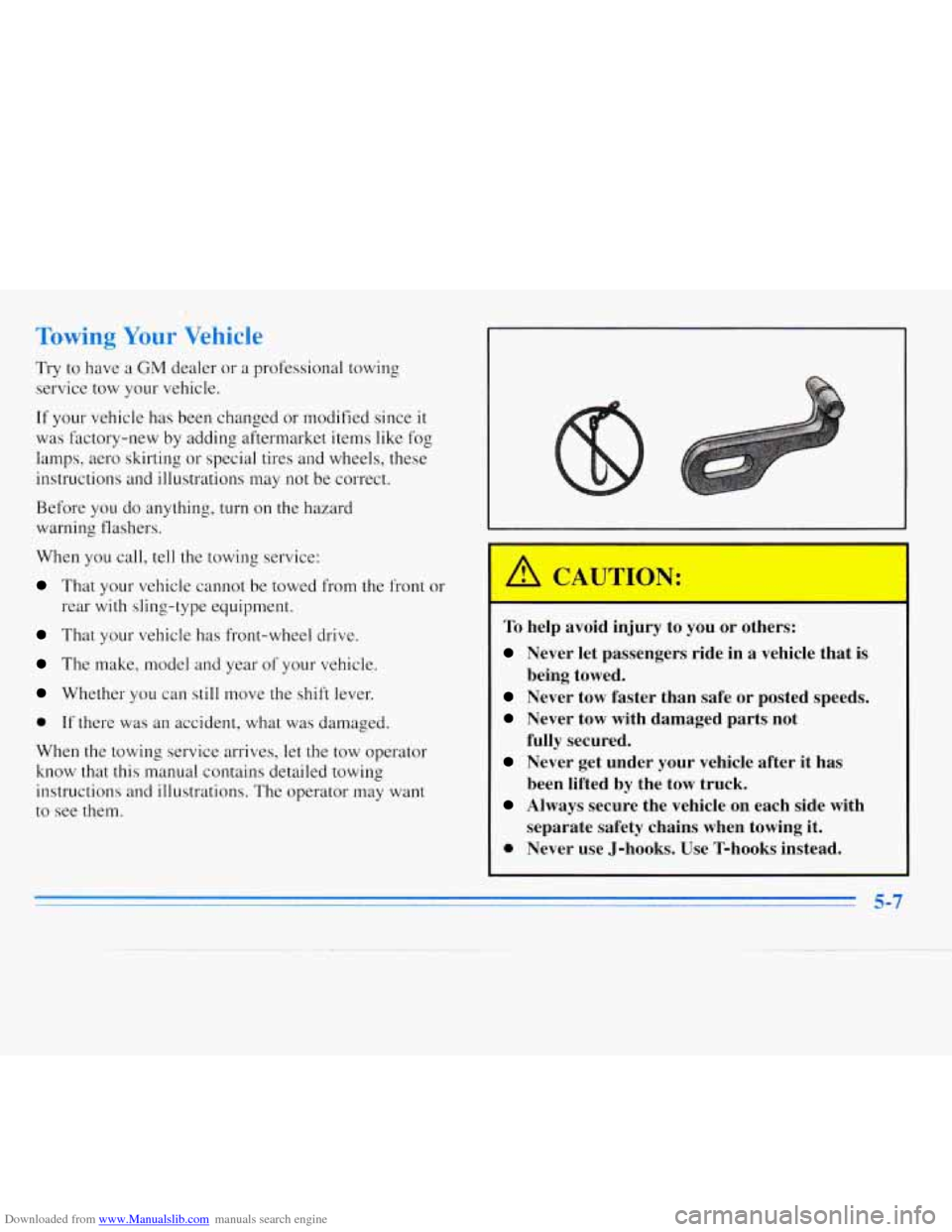
Downloaded from www.Manualslib.com manuals search engine Towing Your Vehicle
Try to have a GM dealer or a professional towing
service tow your vehicle.
If your vehicle has been changed or modified since it
was factory-new by adding aftermarket items like fog
lamps, aero skirting
or special tires and wheels, these
instructions and illustrations may not be correct.
Before you do anything, turn on the hazard
warning flashers.
When you call, tell the towing service:
That your vehicle cannot be towed from the front or
rear with sling-type equipment.
That your vehicle has front-wheel drive.
The make, model and year of your vehicle.
Whether you can still move the shift lever.
0 If there was an accident, what was damaged.
When the towing service arrives, let
the tow operator
know that this manual contains detailed towing
instructions and illustrations. The operator may want
to see them.
U
-
.I
J:
To help avoid injury to you or others:
Never let passengers ride in a vehicle that is
Never tow faster than safe or posted speeds.
Never tow with damaged parts not
fully secured.
Never get under your vehicle after it has
been lifted by the tow truck.
Always secure the vehicle on each side with
separate safety chains when towing it.
0 Never use J-hooks. Use T-hooks instead.
being
towed.
5-7
Page 244 of 340
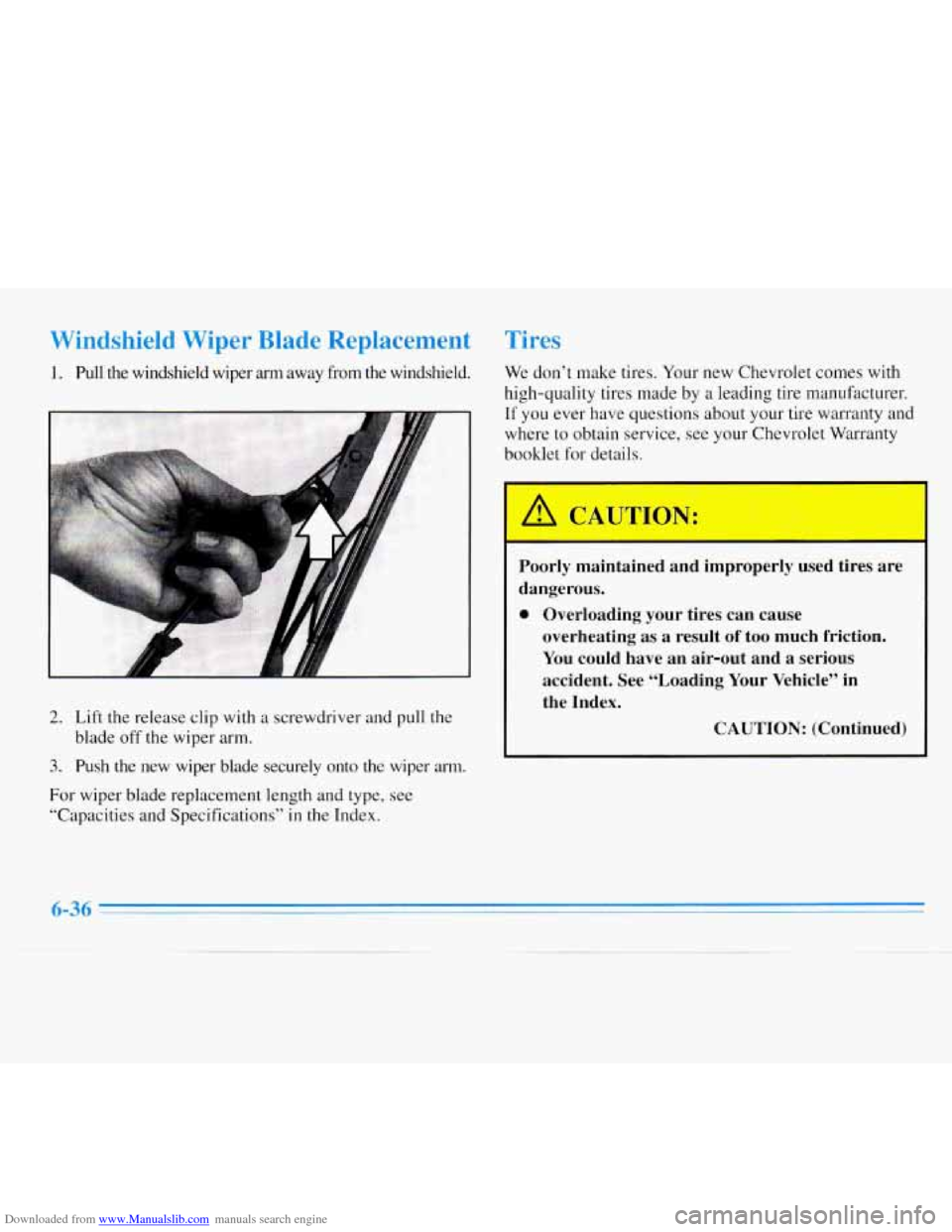
Downloaded from www.Manualslib.com manuals search engine Windshield Wiper Blade Replacement
1. Pull the windshield wiper arm away from the windshield.
r
2. Lift the release clip with a screwdriver and pull the
blade off the wiper arm.
3. Push the new wiper blade securely onto the wiper arm.
Tires
We don’t make tires. Your new Chevrolet comes with
high-quality tires made by a leading tire manufacturer.
If you ever have questions about your tire warranty and
where to obtain service, see your Chevrolet Warranty
booklet for details.
Poorly maintained and improperly used tires are
dangerous.
1
0 Overloading your tires can cause
overheating
as a result of too much friction.
You could have an air-out and a serious
accident. See “Loading Your Vehicle” in
the Index.
CAUTION: (Continued)
For wiper blade replacement length and type, see
”Capacities and Specifications”
in the Index.
6-36
Page 246 of 340

Downloaded from www.Manualslib.com manuals search engine When to Check
Check your tires once a month or more.
Don’t forget your compact spare tire. It should be at
60 psi (420 kPa).
How to Check
Use a good quality pocket-type gage to check tire
pressure. You can’t tell if your tires are properly inflated
simply by looking at them. Radial tires may look
properly ‘inflated
even when they’re underinflated.
Be sure to put the valve caps back
on the valve stems.
They help prevent leaks by keeping out dirt and moisture.
Tire Inspection and Rotation
Tires should be inspected every 6,000 to 8,000 miles
(10 000 to 13 000 km) for any signs of unusual wear.
If unusual wear is present, rotate your tires as soon as
possible and check wheel alignment. Also check for
damaged tires
or wheels. See “When It’s Time for New
Tires’’ and “Wheel Replacement” later in this section for
more information. The purpose
of regular rotation
is to achieve more
uniform wear for
all tires on the vehicle. The kt
rotation is tlle most important. See “Scheduled
Maintenance Services”
in the Index for scheduled
rotation intervals.
Whcn rotating your tires,
always use the correct rotation
pattern
shown here.
Don’t include the compact spare tire
in your tire rotation.
u-30
Page 248 of 340
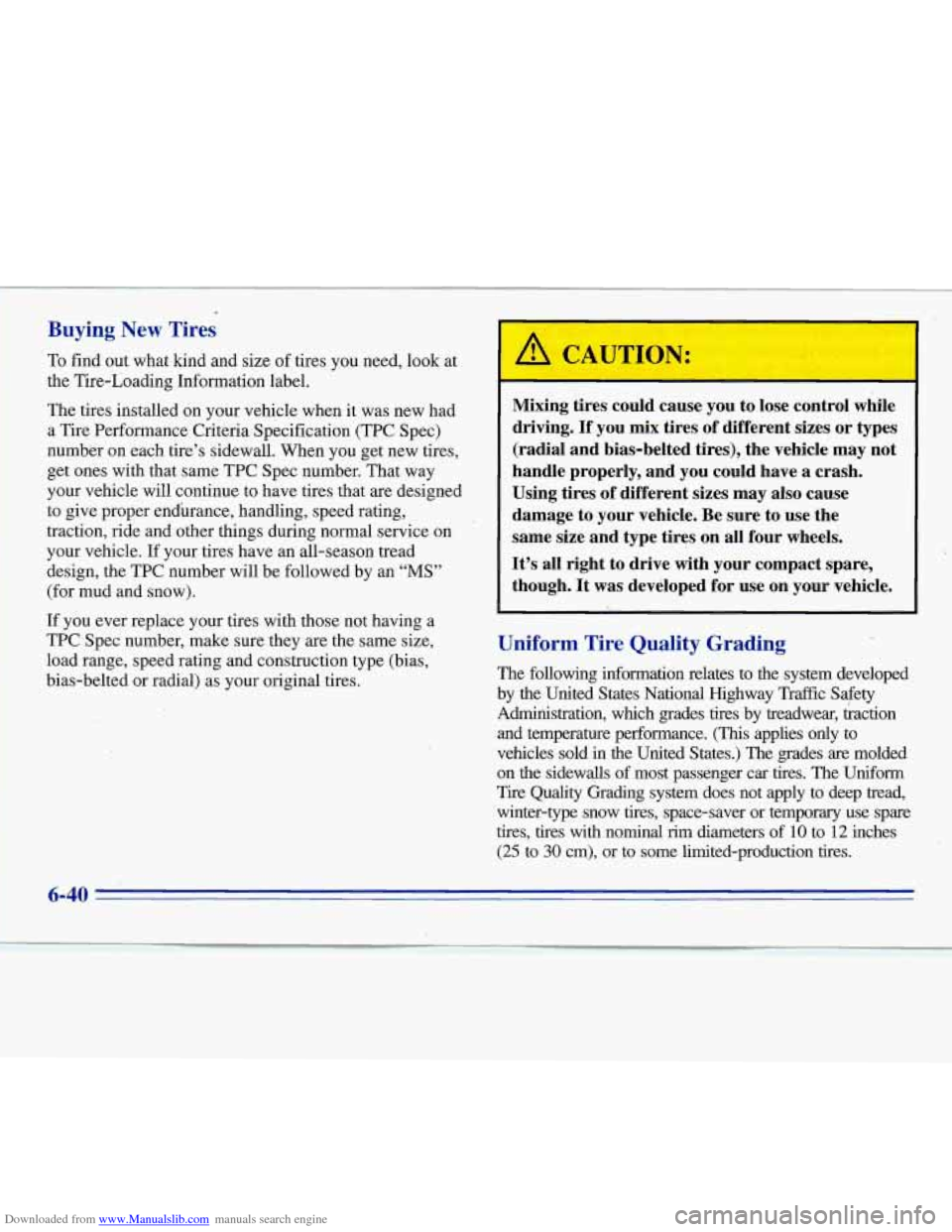
Downloaded from www.Manualslib.com manuals search engine Buying New Tires
To find out what kind and size of tires you need, look at
the Tire-Loading Information label.
The tires installed on your vehicle when
it was new had
a Tire Performance Criteria Specification (TPC Spec)
number on each ti.re’s sidewall. When
you get new tires,
~~ - -I - ~ 4
load range, speed rating and construction type (bias,
bias-belted or radial) as your original tires.
get ones
with that same
TPC Spec number. That way
your vehicle will continue to have tires that are designed
to give proper endurance, handling, speed rating,
traction, ride and other things during normal service on
your vehicle.
If your tires have an all-season tread
design, the TPC number will be followed by an
“MS”
(for mud and snow).
If you ever replace your tires with those not having a
TPC SDec number. make sure thev are the same size, Mixing tires could cause
you to lose control while
driving.
If you mix tires of different sizes or types
(radial and bias-belted tires), the vehicle may not
handle properly, and you could have a crash.
Using tires of different sizes may also cause
damage to your vehicle. Be sure to use the
same size and type tires on all four wheels.
It’s all right to drive with your compact spare,
though. It was developed for use on your vehicle.
Uniform Tire Quality Grading
The following information relates to the system developed
by the United States National Highway Traffic Safety
Administration, which grades tires by treadwear, &action
and temperature performance.
(This applies only to
vehicles sold in the United States.) The grades are molded on the sidewas
of most passenger car tires. The Uniform
Tire Quality Grading system does not apply to deep tread, winter-type snow tires, space-saver or temporary use spare
tires, tires
with nominal rim diameters of 10 to 12 inches
(25 to 30 cm), or to some limited-production tires.
Page 251 of 340
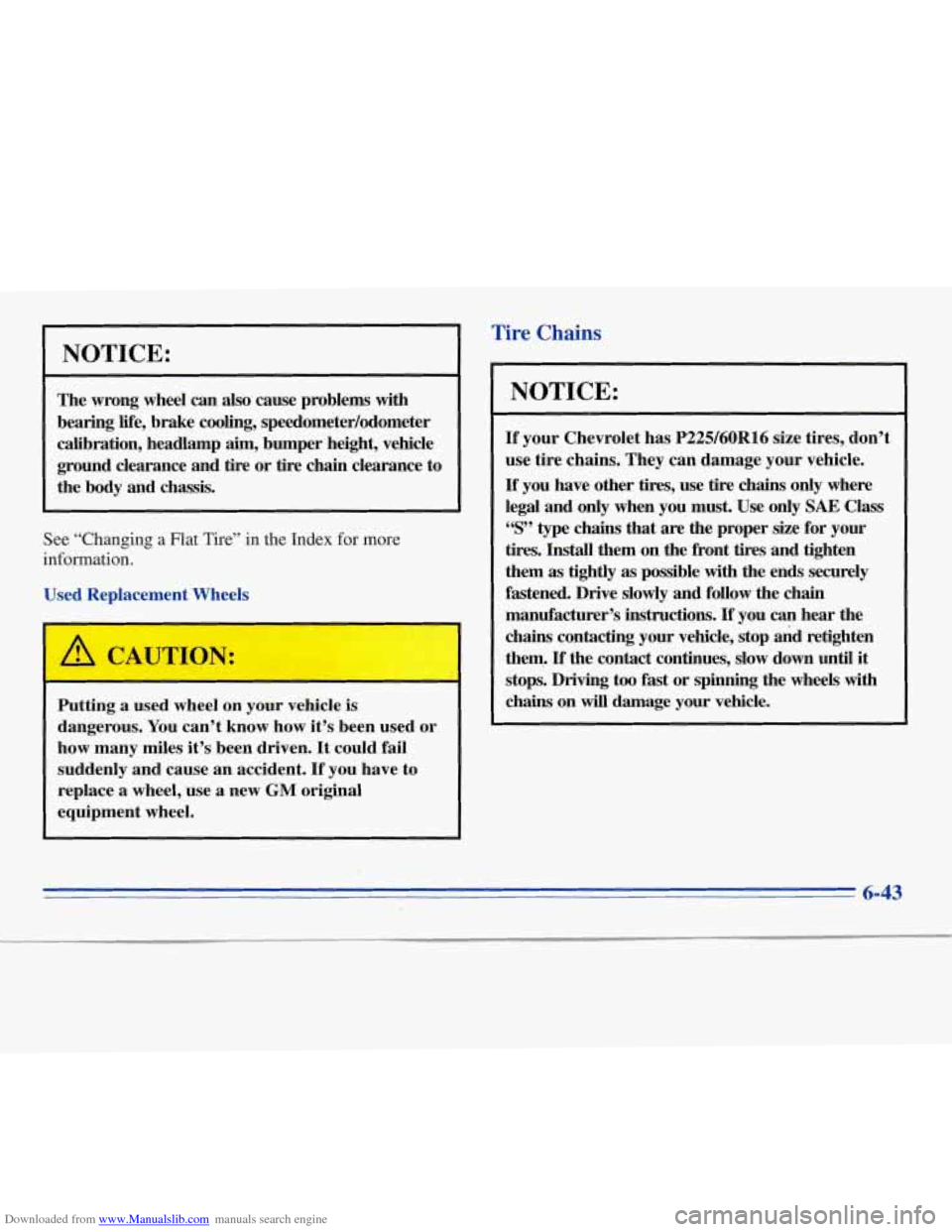
Downloaded from www.Manualslib.com manuals search engine NOTICE:
The wrong wheel can also cause problems with
bearing life, brake cooling, speedometer/odometer
calibration, headlamp aim, bumper height, vehicle
ground clearance and
tire or tire chain clearance to
,the body and chassis.
I I
See “Changing a Flat Tire” in the Index for more
information.
Used Replacement Wheels,
Tire Chains
Putting a used wheel on your vehicle is
dangerous.
You can’t know how it’s been used or
how many miles it’s been driven.
It could fail
suddenly and cause an accident.
If you have to
replace a wheel, use
a new GM original
equipment wheel.
NOTICE:
If your Chevrolet has P22960Rl6 size tires, don’t
use tire chains. They can damage your vehicle.
If you have other tires, use tire chains only where
legal and only when you must. Use only
SAE Class
“S” type chains that are the proper size for your
tires.
Install them on the front tires and tighten
them as tightly as possible with the ends securely
fastened. Drive slowly and follow the chain
manufacturer’s instructions.
If you can hear the
chains contacting your vehicle, stop
&d retighten
them.
If the contact continues, slow down until it
stops. Driving too fast or spinning the wheels with
chains on
will damage your vehicle.
6-43
Page 252 of 340
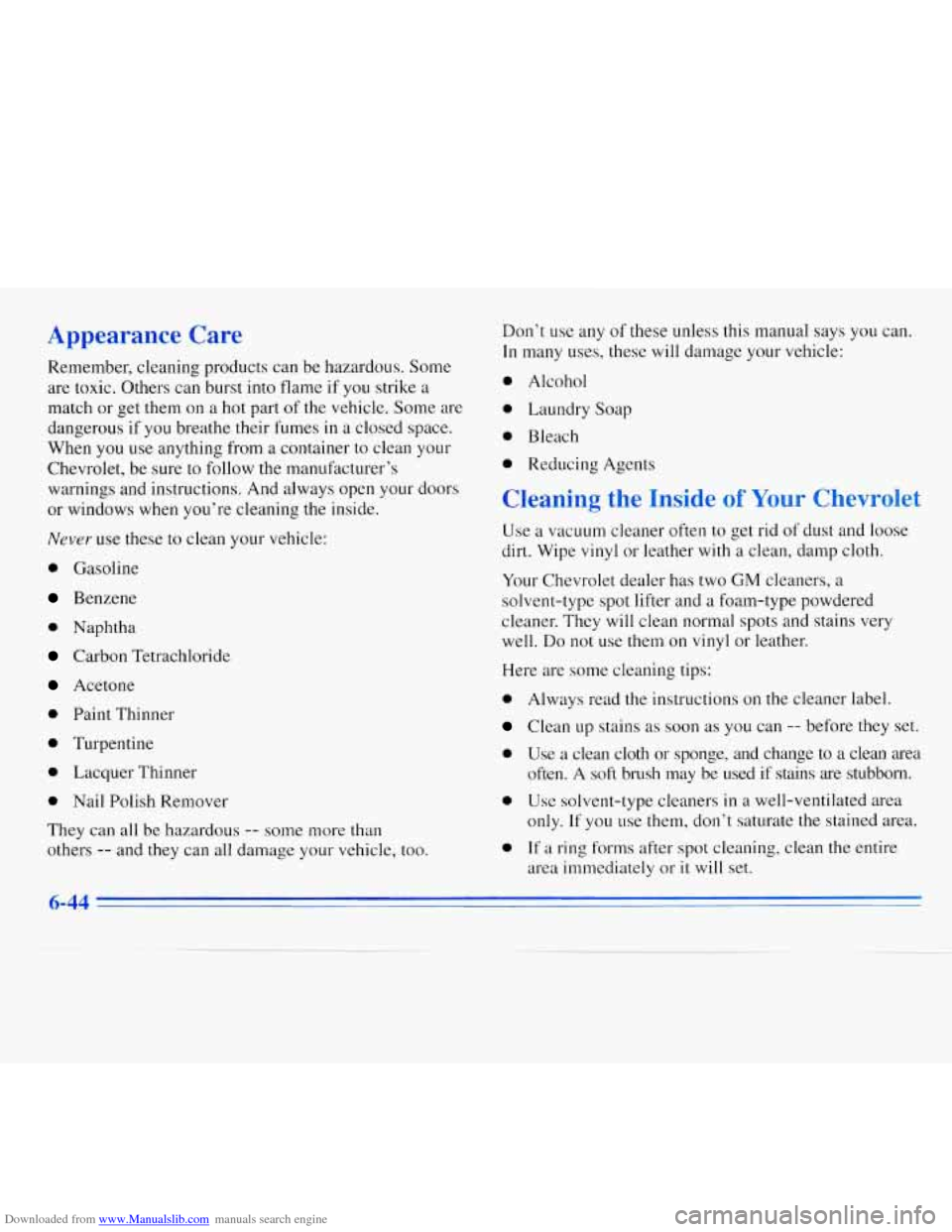
Downloaded from www.Manualslib.com manuals search engine Appearance Care
Remember, cleaning products can be hazardous. Some
are toxic. Others can burst into flame if you strike
a
match or get them on a hot part of the vehicle. Some are
dangerous if you breathe their fumes
in a closed space.
When you use anything from
a container to clean your
Chevrolet, be sure to follow the manufacturer’s
warnings and instructions. And always open your doors
or windows when you’re cleaning the inside.
Never use these to clean your vehicle:
0 Gasoline
Benzene
0 Naphtha
Carbon Tetrachloride
Acetone
0 Paint Thinner
0 Turpentine
0 Lacquer Thinner
0 Nail Polish Remover
They can all be hazardous
-- some more than
others
-- and they can all damage your vehicle, too. Don’t
use any of these unless this manual says you can.
In many uses, these will damage your vehicle:
0 Alcohol
0 Laundry Soap
0 Bleach
0 Reducing Agents
Cleaning the Inside of Your Chevrolet
Use a vacuum cleaner often to get rid of dust and loose
dirt. Wipe
vinyl or leather with a clean, damp cloth.
Your Chevrolet dealer has two GM cleaners,
a
solvent-type spot lifter and a foam-type powdered
cleaner. They will clean normal spots and stains very
well.
Do not use them on vinyl or leather.
Here are some cleaning tips:
0 Always read the instructions on the cleaner label.
Clean up stains as soon as you can -- before they set.
0 Use a clean cloth or sponge, and change to a clean area
0 Use solvent-type cleaners in a well-ventilated area
0 If a ring forms after spot cleaning, clean the entire
often.
A soft brush may
be used if stains are stubborn.
only.
If you use them, don’t saturate the stained area.
area immediately or
it will set.
6-44